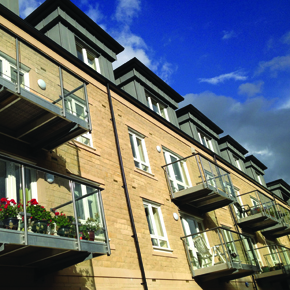
The sustainable benefits of prefabricated balustrades
As one of the more complex and varied architectural elements, balustrade can have especially variable results in terms of site impact and carbon footprint. In the October issue of ABC+D Magazine, Peter Melia, UK business development manager at neaco, explains how making the right choices can deliver major benefits both in the immediate and long term…
Methods
With a multitude of design options on the market, from top rails and stanchion clips to infills and floor fixings, it can be difficult to know where to start when designing balustrade.
Putting aside the aesthetic details for a moment, the best starting point is perhaps the most fundamental consideration: the method of construction and its compatibility with modern practices.
Optimum site efficiency, maximum safety and minimal environmental impact are at the forefront of modern methods of construction.
It is, therefore, desirable to complete as much of the construction off-site as possible and, for that reason, many designers, developers and contractors now prefer pre-fabricated modular systems with all components finished at the factory stage, ready for fast assembly on delivery to site.
The requisite combination of measurements and angles is calculated to a precise degree through consultation between the architect/designer and the manufacturer’s technical support, so time spent on site is significantly reduced.
Modular balustrade components are generally connected with (ideally internal) fixing systems which provide dry works installation – in other words, without the need for hot works such as welding.
The impact on the existing site is substantially lower with less noise, dust, pollution and energy consumption.
Factory conditions also provide superior quality control (with testing, prototyping and checking of uniform quality), avoid on-site delays caused by adverse weather and enable better Health and Safety risk management.
Construction work is a significant waste stream to landfill sites and the controlled factory environment facilitates far better waste management with off-cuts very easily collected for re-use or recycling.
Materials
When it comes to choosing materials, the natural beauty of timber makes it an attractive option, but beware of the natural drawbacks: ongoing treatment is required to maintain its appearance, prevent absorption of bacteria and to control infection.
Timber-effect metal has become an increasingly popular alternative: advanced powder coating can now reproduce the detailed appearance of wood grain as well as opening up a huge variety of other aesthetic options – including numerous RAL and metallic colours – with a maintenance-free, non-chip finish which is smooth, safe and warm to the touch (BS 6300 recommends that handrails should not be cold or hot to the touch and the low thermal conductivity of powder coating addresses this problem). 
Aluminium readily bonds to powder coating and this versatile metal has a number of persuasive advantages: it is lightweight yet durable, non-toxic, non-combustible, corrosive-free and 100% recyclable with no downgrading of its properties and very little energy is required for re-melting.
Like powder coated aluminium, stainless steel offers an attractive aesthetic which is maintenance-free; its sheen can be enhanced by satin polishing applied at the factory stage.
Different grades suit different environments – for example, typically Grade 316 for external use and Grade 304 for dry internal use. Structural glass balustrade is a similarly high-class, low-maintenance option which combines maximum visibility with minimalist style.
Regulations
Balustrade suppliers must ensure that their products comply with the requirements of BS 6180: 2011 which provides a comprehensive guide to the design, structure, height and strength of barriers.
Balustrade must offer suitable horizontal load-bearing capability for its particular environment – for example, in areas where people congregate without crowding, such as a stairs or corridors, it should bear uniformly distributed line load of up to 0.74kN/m, whereas restaurants, retail/public areas not subject to overcrowding and pedestrian areas in car parks require a load-bearing capability of up to 1.5kN/m.
With their manufacturing uniformity and largely standardised components, modular balustrade systems provide reliable and consistent performance in meeting the Building Regulations.
Free-standing structural glass must be toughened in accordance with BS EN 12150-2:2004 – the stronger systems on the market will offer load bearing capability of up to 1.5kN and some manufacturers provide a heatsoaking process to accelerate crystallisation, reducing the risk of potential breakages when the glass is in situ.
When all factors are considered, it is important to remember that the practical, environmental, regulatory and aesthetic demands of balustrade needn’t be competing forces – with expert technical support from a knowledgeable and experienced manufacturer, complex requirements can work together to deliver reliable, consistent and accurate results.
Latest news

24th April 2024
The lowdown on Origin’s New Soho Offering
Origin’s Soho External Door is the first launch in its new generation of products, setting a higher standard for the fenestration industry.
Posted in Access Control & Door Entry Systems, Aluminium Products, Architectural Ironmongery, Articles, Building Industry News, Building Products & Structures, Building Systems, Doors, Innovations & New Products, Posts, Restoration & Refurbishment, Retrofit & Renovation, Security and Fire Protection
24th April 2024
Mitsubishi Electric welcomes new code of conduct for smart appliances
Mitsubishi Electric welcomes a new code of conduct on energy smart appliances which the European Union (EU) announced yesterday at the Hannover Fair in Germany.
Posted in Air Conditioning, Articles, Building Industry Events, Building Industry News, Building Products & Structures, Building Regulations & Accreditations, Building Services, Exhibitions and Conferences, Facility Management & Building Services, Heating Systems, Controls and Management, Heating, Ventilation and Air Conditioning - HVAC, Plumbing, Retrofit & Renovation, Seminars, Sustainability & Energy Efficiency
24th April 2024
Hamworthy Heating expands CIBSE approved CPD modules with new hot water series
Hamworthy Heating, technical experts in commercial heating and hot water products, announce the expansion of its market leading CIBSE approved Continuing Professional Development (CPD) portfolio with the launch of three new learning modules.
Posted in Articles, Building Industry Events, Building Industry News, Building Products & Structures, Building Services, Continuing Professional Development (CPD's), Facility Management & Building Services, Heating Systems, Controls and Management, Heating, Ventilation and Air Conditioning - HVAC, Plumbing, Retrofit & Renovation, Seminars, Training
24th April 2024
New technology partnership brings Passivent ventilation products to IESVE
Passivent has partnered with Integrated Environmental Solutions (IES) to make a number of its products available to model within the Virtual Environment (VE) platform IESVE.
Posted in Air Conditioning, Articles, Building Industry News, Building Products & Structures, Building Services, Facility Management & Building Services, Heating, Ventilation and Air Conditioning - HVAC, Information Technology, Innovations & New Products, Posts, Retrofit & Renovation, Roofs, Ventilation
 Sign up:
Sign up: